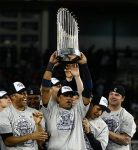Cano’s value stays same with M’s

When the dust settles, Robinson Cano‘s fantasy value really won’t change all that much with news that he’s leaving the New York Yankees for the Seattle Mariners.
Ten years and $240 million, as reported by ESPNDeportes.com’s Enrique Rojas, indeed is a hefty sum, as it would tie for the third-largest total-value contract in baseball history. It takes Cano through his 40th birthday, and a $24 million average annual value seems excessive for the latter stages of the deal when you consider that, among second basemen in ages-38-and-beyond seasons of 100-plus games played at the position (per Baseball-Reference.com), only two players have hit 20-plus homers (Craig Biggio‘s 26 in 2005 and 21 in 2006, and Jeff Kent‘s 20 in 2007), three have batted .300-plus (Eddie Collins, .346 in 1925 and .344 in 1925; Nap Lajoie, .335 in 1913; and Kent, .302 in 2007), and six were worth 2 or more Wins Above Replacement (Lajoie, 5.3 in 1913; Joe Morgan, 5.1 in 1982 and 3.2 in 1983; Collins, 5.1 in 1925 and 4.1 in 1926; Davey Lopes, 2.8 in 1983; Kent, 2.1 in 2007; and Biggio, 2.1 in 2005).
But all that points to Cano’s keeper/dynasty-league value, and if you’re an owner who needs speculate on your squad’s 2021 prospects, then congratulations, you’re more dedicated than I am. Heck, that Cano has signed such a hefty deal with such back-end risk might mean that, by then, his contract is one that could be traded to more favorable fantasy circumstances (see Soriano, Alfonso, for an example of that).
Today, the real takeaways of Cano’s reported signing are twofold: The move from homer-heaven Yankee Stadium to seemingly spacious Safeco Field, and the move from a Yankees lineup with a reputation for league-leading runs totals to a Mariners squad that routinely ranks among the bottom third in the game. The former is sure to draw most fantasy owners’ criticism; it’s the latter that is the more relevant argument, though even that one is sometimes overstated.
Don’t forget that we’re now a year removed from the Mariners having shrunken the dimensions at Safeco Field, though unfortunately for Cano, most of those reductions of between four and 12 feet ranged from the left-field foul pole to right-center field, rather than directly to right. Statistically speaking, though, Safeco did play somewhat better for power in 2013:
Now, that’s not to say that ballpark factors — even using these measures, rather than merely runs or home runs or hits — remain consistent from year to year, and considering how small the dimensional changes in right field at Safeco, those right-field stats might be somewhat fluky. To illustrate this chance of annual fluctuation, as well as roughly outline the difference in park factors between Safeco and Yankee Stadium, here are the latter’s statistical breakdown in 2010-12 compared to 2013:
By those numbers, it sure looks like Yankee Stadium wasn’t as good a park for lefty power, right? Remember, BABIP isn’t the only statistic that can regress to the mean; these underscore that point.
Included is a park overlay to the right, courtesy of Greg Rybarczyk’s ESPN Home Run Tracker site, in an attempt to reduce the panic of a Cano move northwest. It shows that Safeco is a more spacious venue to right field, the direction in which Cano hit 66 of his 79 Yankee Stadium home runs since the park’s opening in 2009, but that the difference isn’t monstrous except directly to right-center field. No matter: Cano’s average home run traveled 403.9 feet in 2013; the major-league average was 396.6. He has the power to clear that wall.
Returning to the lineup point, this is the worry: During the new Yankee Stadium era (2009-13), the Yankees have scored 1,143 more runs than the Mariners, an average of 1.4 per game. But those who followed Cano’s 2013 closely know that the Mariners came within 26 runs of the Yankees last season, or an average of 0.2 runs. In addition, he fills what was a specific hole for his new team, second base: Mariners second basemen combined for .214/.289/.330 triple-slash rates, their .619 OPS second-worst of their nine positions behind only catcher (.579). In other words, he slides into a spot where he’ll provide the maximum upgrade, and into a lineup where he’s a lock to hit third, and if the Mariners figure out that their optimized lineup around Cano probably goes Dustin Ackley (leading off and in center field), Kyle Seager (batting second) and Justin Smoak (fourth) — and that’s assuming they don’t add another top-of-the-order piece to boost their order — Cano’s runs and RBIs might not actually tumble that far from last season’s 81 and 107.
Incidentally, that point about value relative to one’s position — Cano being a substantial upgrade for his new team because of what he’s replacing — is especially pertinent in fantasy. It’s his second base eligibility that makes him such an attractive first-round pick; Cano’s .381 weighted on-base average (wOBA) and .899 OPS last season were 70 and 189 points higher than the major league averages for a second baseman (.311 and .710).
Perhaps Cano’s new, proper over/unders in the key Rotisserie stats are a .300 batting average, 24 home runs and 99 RBIs. But considering positional scarcity and his still-in-his-prime age, that’s still well worthy of a first-round pick, and not a change at all to his No. 5 spot overall in my rankings.